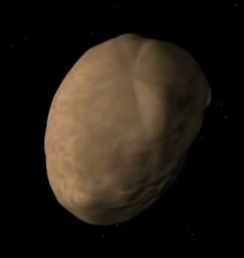| Online: | |
| Visits: | |
| Stories: |
Saturn’s Moon Hyperion -Real View From Space (Video)
Monday, March 3, 2014 16:04
% of readers think this story is Fact. Add your two cents.
(N.Morgan) A Hyperion is the largest known non-spherical body in the solar system. The average diameter for a Hyperion is 270 km (168 miles) but since it is a potato shaped its shape can be described in terms of its diameter along its three axes: 410 x 260 x 220 km (255 x 163 x 137 miles, respectively). In light of its odd shape, the Hyperion is probably a remnant of a larger moon that could have been destroyed by a larger impact.
Hyperion appeared as a tiny dot to astronomers until the Voyager II spacecraft passed through the Saturnian system in 1981, but this view was from a distance. The Voyager images showed the irregular shape, the heavy cratering and the chaotic spin. However, Cassini has filled in details including the curious sponge-like appearance and the presence of complexed compounds.

The most noticeable close-up feature of Hyperion is its deeply cratered surface. Hyperion and its sister outer moons, Phoebe and Iapetus, all show extensive cratering because they are Saturn’s most distant moons and have experienced very little tidal warming that might blur or erase earlier features. However, the Hyperion craters are particularly deep and do not have significant rays of ejecta (although there appears to have been slumping or landslides inside many of the bigger craters). The result is a curiously punched-in look, somewhat like the surface of a sponge or a wasp nest. Planetary geologists have theorized that Hyperion’s high-porosity and low density would crater more by compression than excavation.
Some have theorized that these dark materials at the crater floors would absorb more sunlight and that the resulting “warmth” would deepen the craters as the more volatile materials sublimed away. Those arguing against this theory say that sunlight at Saturn’s distance is too weak to have that effect, particularly in crater floors that are shaded from all but the most direct sunlight.

More Stories:
Texas Man Detained In A Psych Ward & Nursing Home Against His will And Without Due Process (Video)
5 Top Military Brass Security Commanders Defect And Take Oath To Crimea (Video)
Scary New World Order Plans For 2014 By The Illuminati (Stunning Video)
Let’s Escape To The Stars! (Spectacular Video)
They’ve Landed! Russian Naval Infantry In Balaklava, Crimea. March 1st 2014 (Video)
Molon Labe: Come And Take Them! (Video)
Russia Wages War As Banksters Takeover Ukraine (Video)
More Stories Contributed By N. Morgan
Also featured at:
AlternativeNewsToMe1 – Blogspot
AlternativeNewsToMe1 – WordPress




